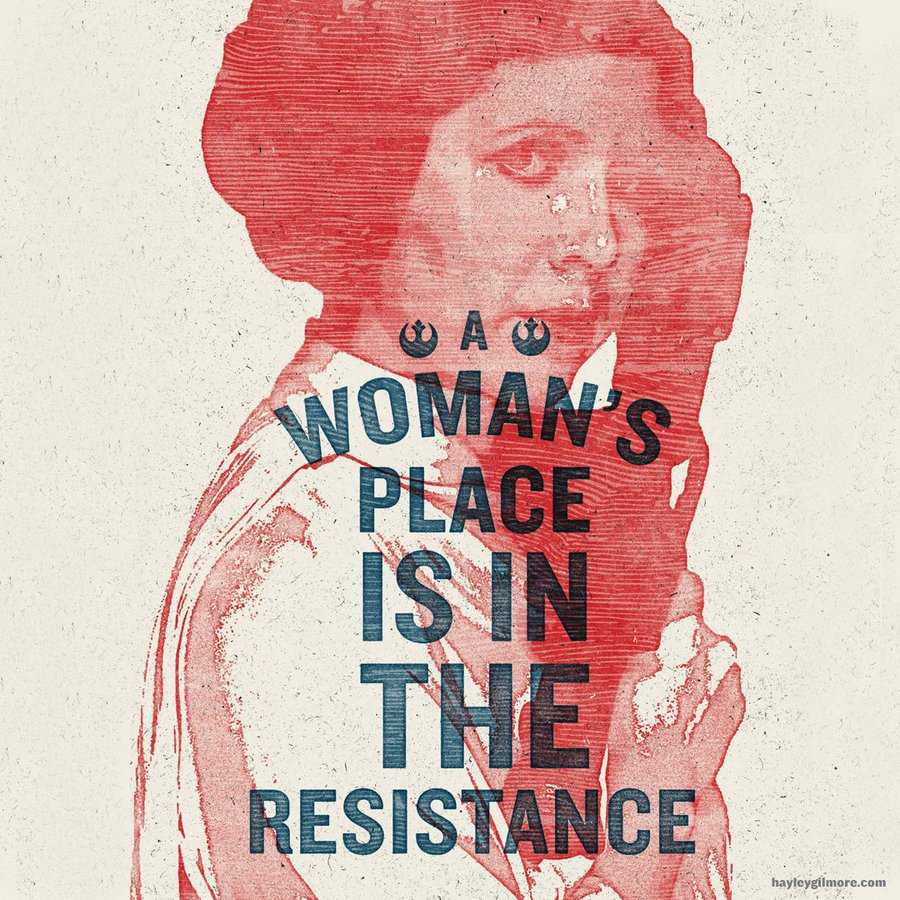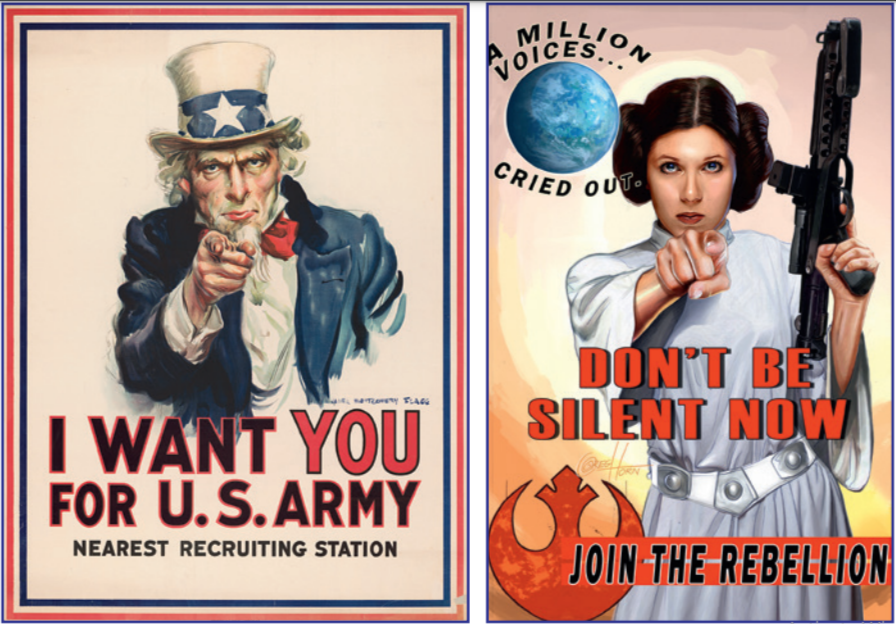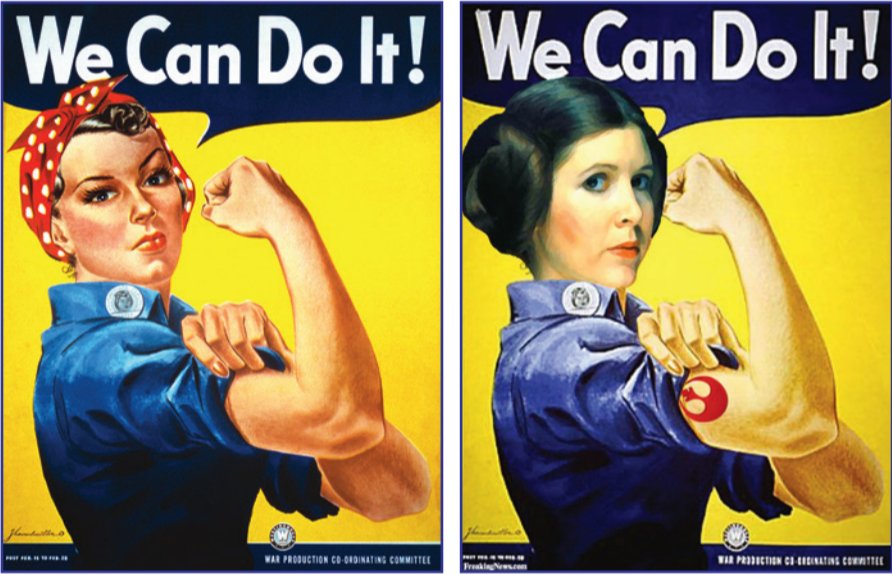To fully understand the cultural space reclaimed through fan protest memes produced as posters for the Women’s March on Washington, we must understand the cultural icons selected from Star Wars — their meaning and context. To this end, we will examine the connection between Carrie Fisher’slife and the proximity of her death to the March and the character of Leia and the ideology associated with her and Star Wars.
Carrie Fisher was an outspoken feminist and mental health advocate through her celebrity as an actress and script doctor, and through her work as a nonfiction author. Fisher passed away on December 27, 2016, and was publicly mourned by Star Wars fan communities and the general public. Her death came roughly a month before the Women’s March on Washington, and the news was still flooded with memorials and tributes to the star. It is no wonder that artists and protestors latched onto her as a feminist icon to leverage within a protest meme, particularly since Carrie herself was in ardent opposition to Trump’s candidacy as president. Alongside posters of Princess Leia, protesters recreated anti-Trump tweets made by Carrie, like, “Trump speaking his mind isn’t refreshing, it’s appalling. CocaCola is refreshing.”

Despite Fisher’s ardent real-life activism, the actress is primarily remembered for her portrayal of Princess Leia, which was originally written as a traditional “damsel in distress” stereotype, but which Fisher revised with her performance as an agented, sarcastic, and feminist heroine. Princess Leia is a major pop icon for various reasons. She has some of the funniest wisecracks in the original trilogy, with sarcastic lines like “Someone has to save our skins. Into the garbage chute, flyboy” (A New Hope) and “You have your moments. Not many of them, but you do have them” (Empire Strikes Back). Princess Leia has substantial agency as a character equally wielding her intelligence, voice, and blaster. As a feminist icon, Princess Leia is on equal footing with her male costars and is in the fray of action throughout all three of the original films. Finally, one cannot completely dismiss the stunning visuals the character provides. Leia is instantly recognizable by her double bun hairstyle, white robes, and yes the gold bikini.
One of the most iconic and problematic scenes in the Star Wars franchise regarding the exploitation of women appears in Return of the Jedi. In this scene, Leia is enslaved, wearing a gold bikini and in chains. Jabba the Hutt, an extraordinarily large and anthropomorphized wormlike alien, has taken “possession” of Leia and makes his sexual desires for her known. Clearly a metaphor for misogyny and oppression, these visuals redeem themselves, at least in part, through Leia’s agency in the rest of this sequence. Leia saves herself from slavery using the chains of bondage to strangle her captor. She uses the trappings of sexist oppression to free not only herself but also to redeem her character as a feminist icon with agency and strength.
Carrie Fisher herself is very critical of this scene and has publicly spoken about the gold bikini and slave motif as being antifeminist. Many feminist fans have rechristened the “slave outfit” as the “Hutt-killer” costume, as they see the only proper use of the outfit is to kill the patriarchy. Fans leverage the image of Princess Leia — Jabba Killer and Fisher’s own feminist rhetoric — in their fan tributes and fan activism protest posters. One poster uses an illustrated “slave” Leia breaking her chains with “Enough” in bold letters, while many others reframe Donald Trump as Jabba the Hutt either through the incorporation of his iconic toupee or the “Make America Great Again” cap. Here we see a poster using an image of Lady Liberty dressed in the Hutt Killer costume, strangling a Jabba/Trump. Given Trump’s history of misogyny and antiwomen rhetoric, it is an easy evolution from the general misogyny associated with Jabba to the specific and real danger of Trump’s presidency.

As General Organa in The Force Awakens, the character of Leia is no less vocal or independent but has grown into a leadership position within the Resistance. Though her screen time is brief, her position and the deference afforded to her by that position speaks volumes. It is important to note that in the tactical meeting, General Organa doesn’t come up with the plan to disable “Starkiller Base” but instead asks questions to highlight flaws and issues that need to be addressed to accomplish the task at hand. However, during battle General Organa is in full command of the battalion of fighters, despite her grief over the loss of Han. This depiction of leadership style is striking in its focus on feminine leadership being less abrasive but no less efficient, purposeful, and effective as the more traditional male presentations of power and leadership.
Leia’s position as General complements her role as mother to her son Ben, also known as Kylo Ren, and her desire for motherhood. Her connection to the force is highlighted in the film through her connection to Han and Rey. In this way, Leia has come to model motherly performance and fulfill the mother role for the newest batch of Resistance fighters: Rey, Poe, and Finn. Her maternal affect, particularly in regard to Rey’s grief over Han’s death, provides complexity to her role as General and another entry for feminist interpretation.
Ultimately, the legacy of Carrie Fisher comedienne, author, mental health and feminist activist cannot be disentangled from the popular memory of the active, sharp-tongued, and agented Princess/General Leia. Fisher was an avid user of social media for political commentary, and, within the Star Wars canon, Princess Leia was no stranger to the use of propaganda. That both the character and the actress are so closely aligned within popular memory contributes toward the use of their image as a meme in the Women’s March, as a tribute to her memory through political speech that protesters feel both Leia and Carrie would support.
The use of popular culture memes in political protest is then a reclamation of physical and cultural public space by protesters. These images rely on the underlying values of fandom culture, American democratic ideals, and the values embedded in the source media text that the meme is referencing. In doing so, fan activist posters merge two intergenerational exchange systems: fandom and protest — encouraging the communication of shared values. In this case the shared value is that of resistance and hope — foundations for freedom.

Among the specific Carrie Fisher tributes, Mark Hamill tweeted images from the protest with the comment “I know where she stood. You know where she stood. Such an honor to see her standing with you today.” Author Anthony Breznican tweeted an image of a protest poster that simply states “Carrie Fisher Sent Me.” He commented, “Carrie Fisher isn’t gone. She was alive and well at the #WomensMarch.” For many protesters the Princess Leia memes are as much a political protest of an oppressive regime as they are a tribute to a fallen hero, whether that hero was the fictional Leia or the very real Carrie Fisher; either way, she was a badass, feminist icon whose presence is still felt today.
Comments
Sign in or become a Nu?Detroit member to join the conversation.
Just enter your email below to get a log in link.